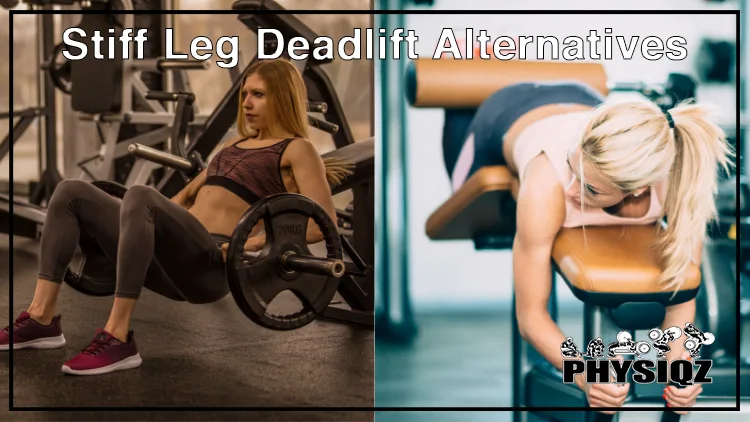
A stiff leg deadlift alternative can provide all the benefits of a stiff legged deadlift, and they’re perfect for lifters who are looking for another hip-hinge exercise and even for those who aren’t able to deadlift with proper form yet or, in the unfortunate case when someone has an injury that stops them from deadlifting.1
No matter the case, there’s one alternative that works even better because it allows for plenty of loading, more stabilization, and a further range of motion. But if you’re already incorporating this one, there are 18 others to choose from, all of which recruit the hamstrings, glutes, back, and rest of the entire thoracic chain in a similar fashion as a stiff leg deadlift.
Stiff Leg Deadlift Alternatives Using Hip Hinge Exercises
There are several superb stiff leg deadlift alternatives that employ the hip hinge (hip hinge is a slight bend at the knees with the torso bending forward by movement of the hips) as the deadlift does. The main one among these is the dumbbell stiff-legged deadlift and others such as the hip thrust with a barbell, single leg hip thrust, kettlebell swings, and sumo deadlifts and squats.
1. Dumbbell Stiff Legged Deadlift – The SLDL Alternative That Works Even Better
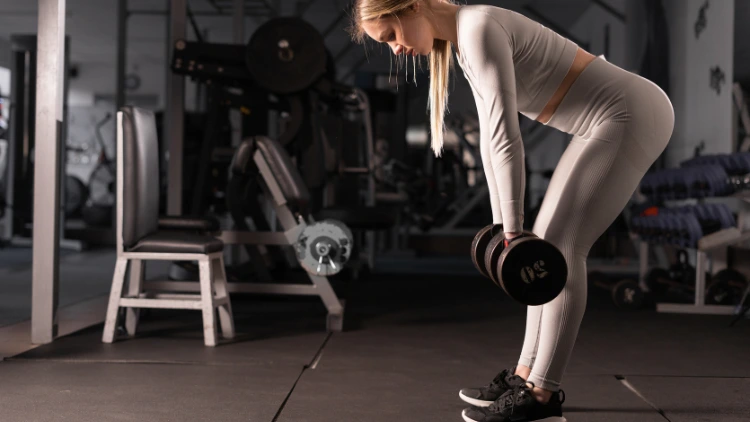
Source: Изображения пользователя Andrii via Canva.com2
The dumbbell stiff-legged deadlift is undeniably the stiff leg deadlift (SLDL) alternative that works even better as a substitute for the stiff leg deadlift. This alternative is excellent for those attempting to introduce variation in their training regimen, especially for those who have reached training plateaus.
The dumbbell deadlift differs from a stiff leg deadlift because it uses dumbbells instead of barbells. It is an excellent alternative to the stiff leg deadlift, especially for those who have injuries because the lifter cannot employ heavy weights—but will likely inhibit experienced lifters searching to build raw strength.
This variation of a deadlift is excellent for achieving hypertrophy, and makes improvements to posture, complementing the main pull—which is the straight leg deadlift which is why it is used by the top 10 bodybuilders of all time.
- Recruitment of lats: Lat engagement is increased in this deadlift since the dumbbells acting independent of one another cause instability to the posture since they swing efficiently, thus addressing muscle imbalances.
- Mastering the pulling technique: Since the dumbbells are separate and detached from each other, the lifter can be in a position to improve and develop the pulling technique (similarly to hook grip vs mixed grip) and balance.
- Improved grip: Dumbbells often have broader handles than barbells, which can improve grip strength. Dominant hands can’t aid the weaker arm since the forearms carry separate weights.
- Increased range of motion (ROM): This kind of deadlift allows for an increased ROM than the regular deadlifts due to the non-use of a barbell resulting in hips and muscles around the knees having increased tension and recruitment, catalyzing muscle growth.
How to perform dumbbell stiff-legged deadlifts: Lifters should have the dumbbells slightly off to the side and not in front as they would do a barbell as this will help keep the shoulder blades pinched at all times.
Descend with knees slightly bent, chest up, and back tight in a controlled and slow motion, especially when the weights pass the knees. As the lifter comes up by pushing the floor away, they should thrust forward with the hips. The head should remain neutral and look straight ahead, and the arms should never be bent throughout the movement.
Where you should feel dumbbell stiff-legged deadlifts: tension should be felt in the hamstrings. If you don’t feel anything during deadlifts, the lifter should reduce the knee bend and lift the chest higher to adjust the weight properly.
2. Hip Thrust With Barbell
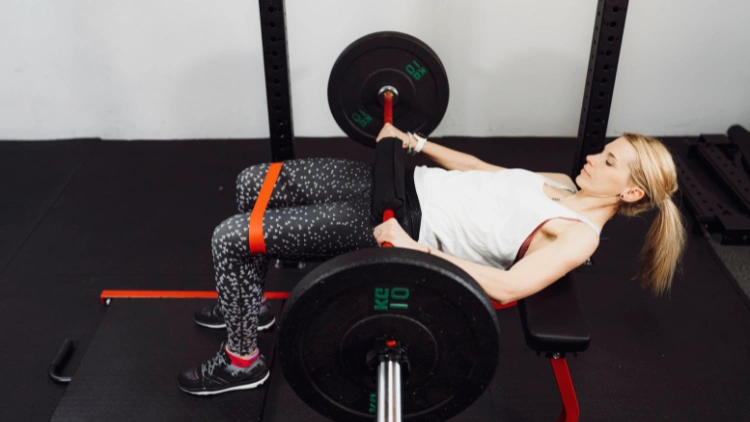
Source: Ziga Plahutar via Canva.com3
Hip thrusts are a viable alternative to stiff leg deadlifts because they are an excellent staple to developing strong glutes—strong glutes carry over to most exercises in the gym and are helpful in everyday life. As the glutes are the primary mover here, a few weeks of this exercise will see tremendous improvements in conventional deadlifts and back squats.
Most of the population lead a sedentary life or work while sitting; mastering the technique of stabilizing the spine and hip extension (the angle between the torso and the hips) has excellent benefits for the lower back. The barbell hip thrust allows individuals to transition into compound movements (squats, deadlifts, etc.) and improve human locomotion activities—running, standing, jumping, and sprinting.4 They are helpful when heavy hinges (bending forward through a motion of the hips with knees slightly bent), such as deadlifts or Romanian deadlifts, are not ideal for lifters in pain.
Hip thrusts differ from SLDS in that they are not done while in a standing position but rather lying partially on a bench; they tend to recruit the glutes more than hamstrings and target the adductors (muscles of the inner groin).
- Glute strength: This exercise thoroughly addresses hypertrophy and strengthening of the glutes. The barbell can be loaded heavily to enhance strength or lightly to build endurance.
- Fitness levels: This exercise is ideal for individuals of varying fitness levels, from novice to professional individuals. It can be used with both body weights and dumbbells for added resistance.
- Powerlifters and bodybuilders: They are great for powerlifters and bodybuilders alike as they can enhance deadlifts and squats since they improve hip extension and are ideal for warm-ups for both athletes and bodybuilders. Between a powerlifter physique vs bodybuilder physique, both tend to benefit from including this regimen.
How to perform hip thrust with a barbell: To perform this exercise, the lifter should sit with their back to the bench, ensuring that it is parallel to them. A barbell loaded with weight is then placed on the crease of the hip. The feet should not be not too close to the glutes.
When the barbell is secure at the crease, the firmly planted feet should be driven down, which results in the legs bending and the back driven rear towards the bench. Once the lifter has leaned on the bench, they will ensure that the shoulder blades are on the bench and are in a straight line with the upper body and hips.
The lifter is set to initiate and should pull the abdominals tight and ensure their back is flat. They should not arch the lumbar (lower back) as they will end up misloading the hips when in the bottom position.
The torso should be locked in, allowing the hips to move up and down, making the torso a lever—the core should always be engaged to prevent instability and should hold at the top for a second or two with a glute squeeze.
Where you should feel hip thrust with a barbell: The hip thrust will be felt most in the glutes which are the primary mover and target muscle for this exercise.
3. Single Leg Hip Thrust
The single-leg hip thrust is a modification of the hip thrust with a barbell, with the apparent difference being that this is done using one leg at a time. It is an excellent option since it will address imbalances by unilaterally isolating the glutes. It has a low risk of injury and will be an excellent alternative for those in pain or with any injury.
- Improved hip extension: Since this exercise isolates the glutes, it does go towards aiding in improving hip-extension performance. The single-leg hip thrust recruits the glutes more than the deadlifts.5
- Increased athletic performance: Having a strong lower body means athletic activities such as running, sprinting, or jumping become much more manageable.6
How to perform single-leg hip thrust: Setting up here should be the same as the hip thrust detailed above but with one leg. The other leg should float in front of the one planted on the floor. Push with one glute and hold at the top for a second for peak contraction. This is a very challenging exercise and not a lot of weight can be used here. The hands will need to be relaxed during this movement and there should be no pushing with the elbows.
Where you should feel single-leg hip thrust: The single-leg hip thrust just like the hip thrust with a barbell will primarily target the glutes as they are the primary movers. The spinal erectors (mid and lower muscles), adductors, quads, hips, and hamstrings will be secondary muscles.
4. Single Leg Romanian Deadlift (SLRDL)
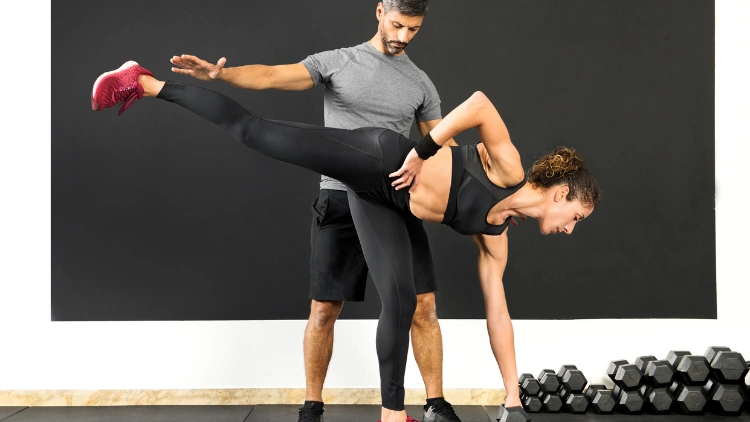
Source: photology2000 via Canva.com7
The single-leg Romanian deadlift (staggered deadlift) is an exercise that is an excellent recruiter of the posterior chain—these are the muscle groups that are on the back of the body down to the calf muscles and they’re one of the hardest muscles to grow. They include the latissimus dorsi (muscles along the spine), hamstrings, and glutes. This exercise is excellent for enhancing leg stability because the unilateral nature prevents future injuries, increases athletic performance, and improves balance.
SLRDL will be a great tool that allows the lifter to master the hip hinge and carries into movements that are hip dominant. It is an exercise that helps those who are avoiding knee-dominant movements, especially if they have pain doing deadlifts.
- Grip does not limit: Due to the unilateral nature of SLRDL, the total effort put in compared to a Romanian deadlift is less than the SLRDL but without loss of grip. To put this in perspective, someone can SLRDL 200 pounds and is unable to RDL (Romanian deadlift) 400 pounds due to grip failure.
- Assessment performance tool: This exercise can be a tool to gauge a lifter’s movement patterns, such as hip positioning, that cannot be seen in an SLRDL.
- Adductor strength: The hip hinge pattern employed here will allow the lifter to strengthen their adductors which can be carried over to other movements.
- Improves balance: Standing on one leg helps an athlete improve their balance and coordination by targeting the 3 sensory systems—vestibular, somatosensory (touch, muscle stretch, etc.), and vision.
How to perform a single-leg Romanian deadlift: This exercise is initiated by standing tall and planting one foot into the floor and then creating a slight bend at the knee of the planted foot. It can be done with and without weights. The lifter should then hinge at the hips while lowering the torso forward, which should not exceed parallel.
The other leg is raised behind as far as possible and comfortable while maintaining a neutral spine. Lifters should then exhale and extend their hips to return to starting position.
Where you should feel single leg Romanian deadlift: Single leg Romanian deadlift should be felt in the hamstrings, which are the primary movers here. It will also be felt in the lower back and, to some extent, engage the lats and the glutes.
5. Cable Pull-Through
Cable pull-throughs effectively target the glutes and serve as an alternative to stiff leg deadlifts. Lifters should always incorporate them into their regimen because relying solely on deadlifts and squats will result in gains being left on the table. Compounds typically tax the body due to heavy load, but these exercises can be done with a light load but at a higher volume.
They are great for beginners, powerlifters, and bodybuilders by increasing glute recruitment and hypertrophy. Using the cable will enhance the mind-muscle connection since the cable will always provide the lifter with a response on form and is a cable stiff leg deadlift alternative.
- Less stress to the back: They will induce efficient glute growth while ensuring very little stress is placed on the lower back, making them an excellent alternative.
- The hip hinge: This will help both novices and professionals master the hip hinge without the stress placed on the lower back that other compound movements produce.
- Recruitment of the posterior chain: The cables will facilitate increased time under tension for the posterior chain and recruit the glutes in a controlled and slow movement.
How to perform the cable pull-through: The lifter should stand tall with feet firmly planted and hinge at the hips to pull the cable through the legs, sit back into the hips, stretch through the hamstrings, and maintain a good straight back position. Lifters do not have to bend all the way down while descending, but when ascending, they will need to ensure that they are pushing their glutes all the way through for a 1-2 second squeeze while tensing the core.
Where you should feel cable pull-through: The cable pull-through should primarily be felt in the glutes, which are the primary mover for this exercise. They will also feel them at the hamstrings, which are recruited.
6. Good Mornings – Low Bar & High Bar
Good mornings are an exercise for recruiting the posterior chain and are great at allowing lifters to master the hip hinge that is critical for compound movements. The main downside of this exercise is if not done properly, there is a very high risk of injury due to leaning forward with a weight on the back.
The good morning targets the hamstrings and glutes since they facilitate the hinging by extending the hips on the eccentric (muscle’s ability to absorb force and react by producing an equal contraction). Erector spinae (lower back) muscles are used to maintain stability in the torso during the eccentric and are engaged.
There are two variations, the low bar, where the bar is over the rear delts, and the high bar has the bar placed on the base of the neck on the upper back. The disadvantage of the high bar is that the center of gravity is forward, and the lifter may not go deep enough.
Good mornings are similar to stiff leg deadlifts due to the hip hinge, which is done within a standing position with a barbell. However, that is where the similarity ends as the movement remains above the waist, and the bar does not go below the knees.
- Lower and upper back: This exercise works the lower back and strengthens it, leading to a healthier lower back. By recruiting upper back tension, lifters can perform better in exercises like squats if they are susceptible to falling forward, inhibiting the squat bar path.
- Glutes and hamstrings: Since the glutes and hamstrings are recruited, this strengthens, and hypertrophy is catalyzed.
How to perform good mornings: Low bar & high bar—with the bar over the rear delts or upper back, the lifter should have the chest up and big, the back remaining flat and never rounded, the lifter will lean forward with knees slightly bent.
Where you should feel good mornings: Low bar & high bar—this exercise should be felt at the back of the leg and hamstrings. If this is not felt, the chest will need to be higher and the knees a little bent less.
7. Kettlebell Swings
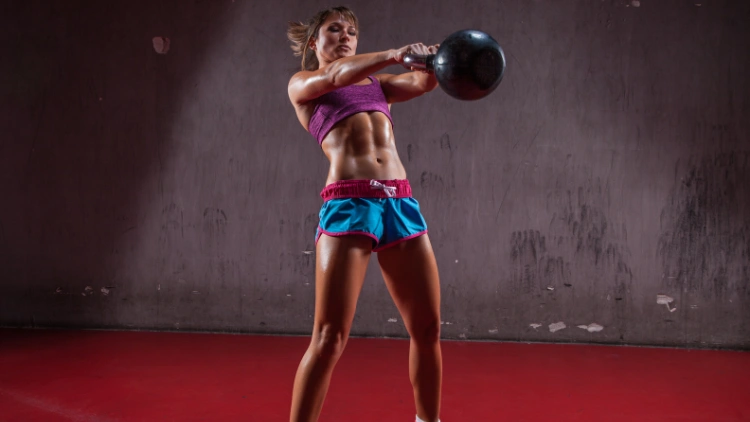
Source: Bojan656 via Canva.com8
Kettlebell swings using a kettlebell are excellent in mastering the hip hinge since they provide instant reaction to the lifter on the hip hinge technique. It is different from SLDL in that it uses a kettlebell, unlike a bar that is swung. Kettlebell swinging which is periodized (varying exercises by modifying intensity, frequency, and volume), when done weekly, can amplify an athlete’s strength and ability to project force—they are as effective as landmine deadlifts.9
Kettlebell swings involve mostly horizontal forces, which means less shearing on the spine and less risk of injuring the lower back, making it ideal for individuals with pain and injuries.10
- Improves hip hinge: Kettlebell swings are hip hinges done at high volume and engage the glutes allowing the lifter to master the hip hinge.11
- Boosts athleticism: They are an excellent cardio workout employing the cardiovascular system.12 They strengthen the posterior chain and improve athleticism.
- Low impact: This exercise is easy on the knees and lower spine making it excellent for those with these issues while still providing strength.
- Spinal health: Swinging the kettlebell is excellent for strengthening the spine and will make it easy for the spine to absorb sudden pressure.13
How to perform kettlebell swings: Lift the kettlebell with the back flat, ensuring tension in the arms and lats. Get into the standing position and hip hinge while swinging the kettlebell between the legs and return to the upright position.
Where you should feel kettlebell swings: This exercise should be felt in the glutes and the hamstrings. The lats are also engaged as a result of it.
8. Sumo Deadlifts & Squats
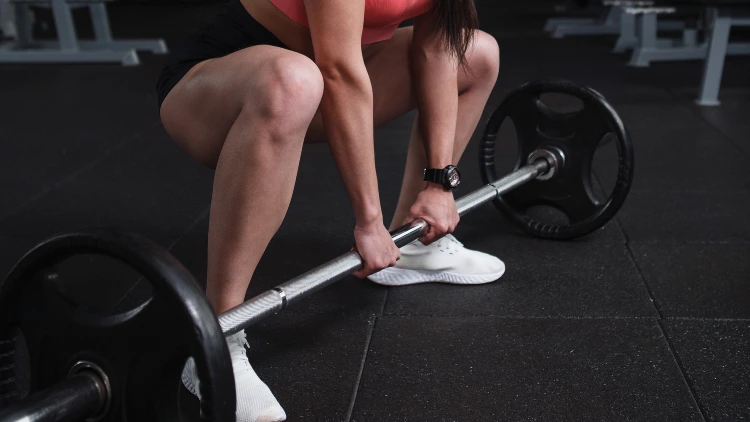
Source: madproduction via Canva.com14
The sumo deadlift and squat vary from the conventional deadlift and squat because they are done with a very wide stance by opening up the hips. They are great for powerlifters, gym goers, and those in Crossfit due to the decreased range of motion that facilitates a decreased hip hinge, resulting in lifters hauling more weight.
- Comfortable mechanics: The wider stance demanded by the exercise combined with arms being narrower than a conventional deadlift allows a smaller ROM agreeable to many individuals.
- Less back stress: This type of deadlift and squat places less stress on the lower back making it an excellent choice for those with injuries or who have lower back pain when deadlifting and squatting.
- Engagement of quads: This type of deadlift engages the quads more and can improve their strength in the quads.
How to perform sumo deadlifts & squats: Feet should be at a wide stance and bar close to the body with chest out, maintaining a neutral spine—they may round the thoracic (middle part of the spine). The lifter should then drive through the midfoot, keeping the bar close to the body, stop the bar on the floor, and then restart the lift.
Where you should feel sumo deadlifts & squats: Should be felt primarily on the hamstrings and glutes but the quads are also engaged as well in this exercise.
9. Trap Bar Deadlift
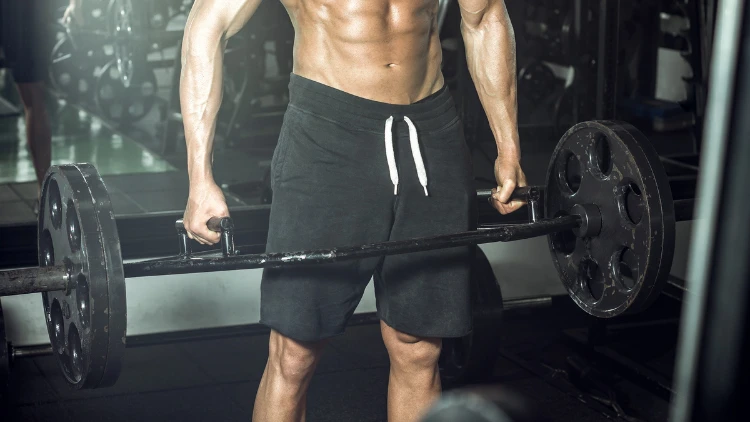
Source: Ozimician via Canva.com15
A trap bar deadlift uses a trap bar which allows the lifter to align closer to the center of gravity, increasing leverage and allowing for a more upright stance. It varies with SLDL because the knees are slightly bent, involving less hip hinge. Adding to other compound movements, such as the sumo deadlift, is a significant variation.
- Great for beginners: This is excellent to introduce lifters to the pulling technique before transitioning to stiff-legged deadlifts.
- Less stress on the lower back: The upright posture places less emphasis on the lower back, which makes it an excellent option for those recovering from back injuries or who have pain when they SLDL.
- Leg and glute engagement: Due to the posture that places the torso upright, there is increased recruitment of the glutes and the quads.
- Increased load: The trap bar deadlift can be used to load heavy weight making it an excellent choice for lifters wanting to bring variation to their regimens.
How to perform trap bar deadlift: The lifter would need to grab right in the middle of the trap bar, keep the chest out, back tight and bend at the knees and hips as in a conventional deadlift and push the floor away. It is essential to grip the middle as the bar may feel awkward as it falls onto the lifter.
Where you should feel trap bar deadlift: Exercise engages the glutes and quads and should be felt there. Hamstrings are worked but to a lesser degree than the conventional or Romanian deadlifts. There is some quad engagement as well.
10. Machine Hip Thrust
Machine hip thrust facilitates the hip thrust using an L-shaped machine, which most lifters find easy and comfortable to use. There is no need for the lifter to balance the barbell, and it allows for efficient glute engagement, making it a machine alternative to stiff leg deadlifts.
- Stability: The machine provides stability for the lifter, allowing them to solely engage the glutes, making them excellent for those recovering from injury. Using this device is ideal for bringing variation to the regimen.
- Safety: Since there is no barbell or weight to place on the body, the machine reduces the risk of injury and can be an excellent tool for beginners to learn the movement.
How to perform machine hip thrust: The lifter should slide in the machine, lower the lap bar, grip the handles and the feet should be adjusted to have a lap bar across the hips. Proceed then to lift up on the lap bar, push the locking handle away, and perform the thrust to hold the top squeeze for 1 or 2 seconds.
Where you should feel machine hip thrust: The hip thrust will be felt most in the glutes, which are the primary mover and target muscle.
11. Paused Stiff Leg Deadlift
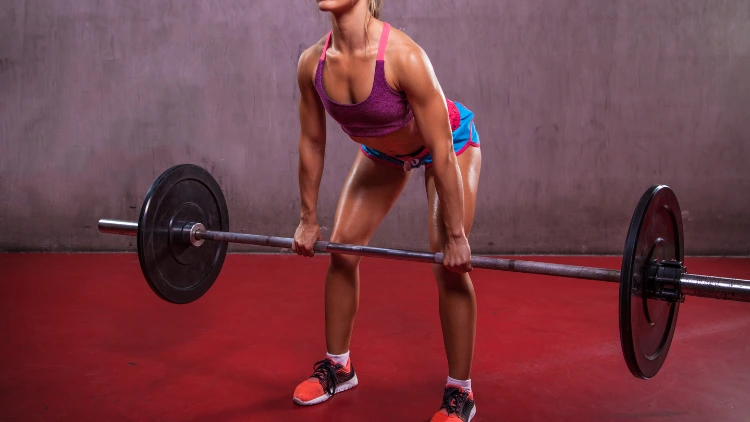
Source: Bojan656 via Canva.com16
This deadlift is a variation of the stiff leg deadlift with a pause of about 2 seconds between the ground and the knees. They differ from regular SLDL due to the pause, but the form and technique remain the same—it enforces technique.
- Torso and shoulder angle: This exercise helps the lifter master the optimal angle between the torso and shoulder since the pause will emphasize this.
- Addresses weaknesses and recruits quads: The pause will allow for more tension on the knee muscles, which are extended by the quads; thus, any weaknesses they may have is addressed here.
- Eliminates the need for heavy loading: The pause intensifies the deadlift, allowing the load not to be very heavy making it great for those suffering from injuries or pain.
- Transfer over to the deadlift: The exercise allows the lifter to carry on to the deadlift since the bottom end is effectively mastered.
How to perform a paused stiff leg deadlift: Lifters should do this as they would with an SLDL, but a pause is held between the knees and the ground for 2 seconds before exploding upwards after the motionless state to the lockout. The bar must remain motionless. Shoulders should be stacked either on top of the barbell or slightly in front.
Where you should feel a paused stiff leg deadlift: This movement targets the hamstrings.
12. Glute Hamstring Raise as a Stiff Leg Deadlift Alternative
As the name suggests, the glute hamstring raise targets the hamstrings and glutes. It differs from the SLDS because it is completely in a horizontal position without the use of weights but instead uses the weight of the body and is done on a bench. It is an excellent exercise for targeting the posterior chain as well.
- Carry over to other compound movements: This increases the lifter’s ability to carry on to other compound movements by increasing hamstring and glute strength.
- Posterior chain performance: The hamstrings are heavily recruited in this exercise due to the extended time under tension and a complete ROM which increases the performance of the posterior chain.
How to perform glute hamstring raise: Lifters should lie on the glute raise bench, secure their legs, and should lift themselves in a slow and controlled manner. They should ensure that most of the motion comes off the knee joint.
Where you should feel glute hamstring raise: This exercise should be felt mostly in the glutes and hamstrings. However, the posterior chain as a whole will be targeted.
Other Stiff Legged Deadlift Alternatives & Replacements
There are other stiff leg deadlift alternatives and 18 others that serve as supplements that can be used as replacements for SLDL. These, however, differ from hip hinges and involve more squatting motion targeting the leg muscles. In addition, they will target glutes and include belt squats, lying or seated leg curls, glute kickback with bands or machines, and reverse lunges.
13. Belt Squat
Unlike squats and deadlifts, which are natural movements, the belt squat is not but the advantage of using this device is that it strengthens the legs and hips and places little stress on the back.
It is excellent for individuals with hip pain when they squat or those suffering from injuries, and it can be seen as a variation like the smith machine where it’s not as beneficial, but it’s still an excellent movement. For those questioning the use of Smith machines, they aren’t bad; like the belt squat, they have their place in a workout routine.
The belt squat is great for adding variation to a training regimen and can help individuals and squat and deadlift the same day with the belt squat being a perfect substitute that’s less fatiguing.
- Less stress on the back: The lifter can place the load on the lower body by using the upper body, placing less stress on the back making it ideal for individuals with back and shoulder issues.
- Glute intensive: The nature of the contraption forces glute contraction to enable complete hip extension, making it excellent for the glutes.
- Lifters with injuries: The belt squat allows those with injuries either in the hips or upper body to still successfully squat.
How to perform glute hamstring raise: Simply attach the belt to the lifter and proceed to squat after putting in the desired weight.
Where you should feel glute hamstring raise: The belt squat activates the quads and glutes as well and can be felt there.
14. Lying or Seated Leg Curls
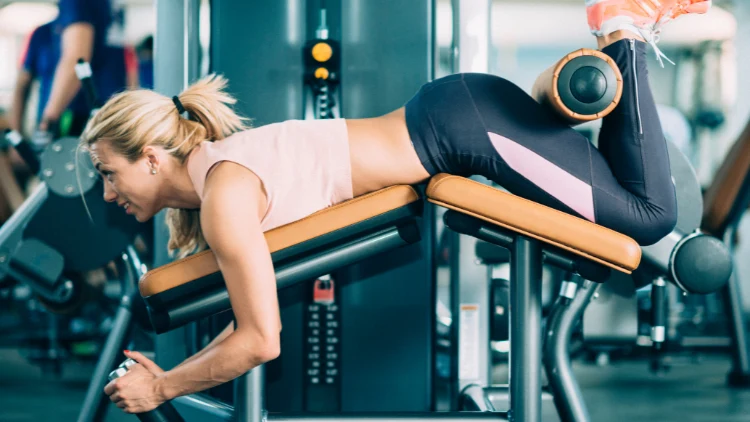
Source: microgen via Canva.com17
Lying or seated leg curls are excellent exercises for hamstrings. The lying leg version has less hamstring flexion resulting in less muscle recruitment. The seated curl has the hamstring loaded in a longer state, making it more effective and inducing hypertrophy than the lying leg curl.18
- Less stress on the lower back: Lying leg curls put less stress on the back, which allows those with injuries or low back pain to still target and work their hamstrings.
- Engagement of the hamstrings: The lying leg curls engage the hamstring more than the SLDL, making it an excellent alternative.
How to perform lying or seated leg curls: Simply sit or lay on the leg curling machine and adjust the weight accordingly to ensure a full range of motion.
Where you should feel lying or seated leg curls: These exercises engage the hamstrings and will be felt primarily there. However, they will also engage the calf muscles and glutes.
15. Glute Kickback With Bands or Machines
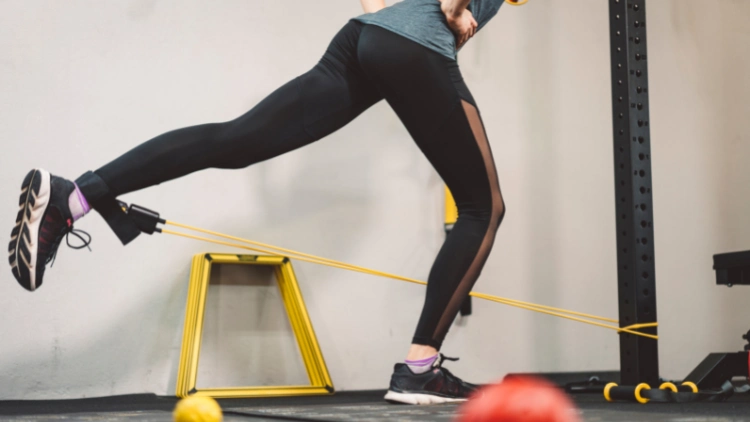
Source: Ziga Plahutar via Canva.com19
Glute kickbacks with bands or machines commonly found in planet fitness are an excellent staple for building glute strength which carries over to other exercises. The machine will tone the glutes, core, and leg muscles. They are not a hip hinge exercise but do effectively work out the lower body and are low impact and can give a result similar to a peloton strength before and after transformation.
- Less stress on the lower back: It is a low-impact exercise that releases tension in the lower back due to potentially misaligned hips and may provide relief for those suffering from lower back pain.
- Improves balance and posture: Glute kickbacks can help improve posture by re-aligning hips and will improve mind-muscle connection with the core, primarily when exercise is controlled and slow.
- Strengthens glutes: It encourages hypertrophy of the glutes and strengthens them.
How to perform glute kickback with bands or machines: Face the machine with feet apart, one foot having the band, and keep the body straight with one hand to the machine. With a leg that is a straight push with the glutes in a slow and controlled manner.
Where you should feel glute kickback with bands or machines: This exercise is felt in the glues. However, it will engage the core as well.
16. Dumbbell Split Squat
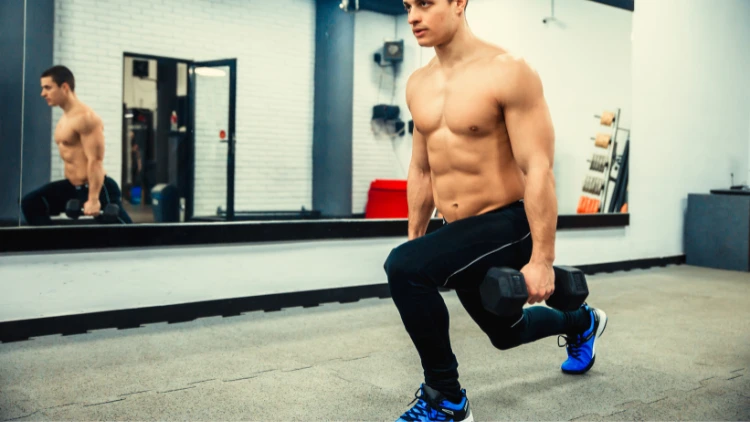
Source: LordHenriVoton via Canva.com20
The dumb split squat is a variation of the squat performed with dumbbells that are unilateral and is excellent at targeting muscle imbalance while targeting the core and increasing mobility.
- Addresses imbalances: Muscle imbalances caused by dominant legs can be cured by this exercise, reducing the risk of injuries on the overworked dominant leg.
- Carry on to other movements: By increasing awareness and balance, the lifter will be able to carry these to other compound movements such as squats.
How to perform dumbbell split squat: Lifters should hold two dumbbells by their side and have one leg to the rear that can either be on a bench or supported by the toes. Descend by bending at the hips and ensuring that full depth can be obtained while maintaining stability.
Where you should feel dumbbell split squat: This should be felt in the glutes and quads. In addition to these parts, the core and hamstrings are targeted by this exercise.
17. Reverse Lunge
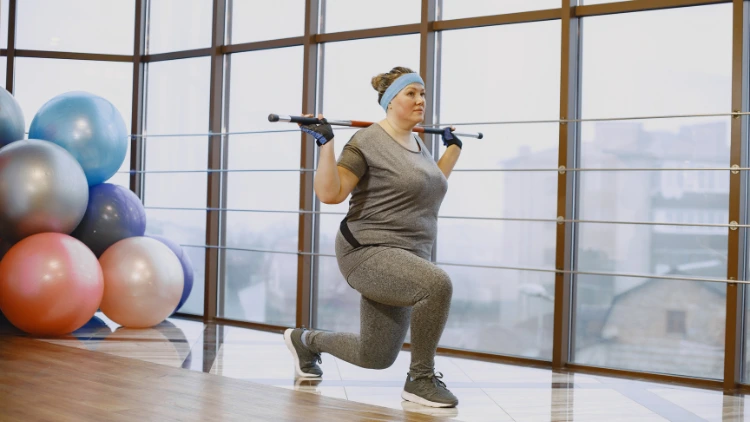
Source: Helgy via Canva.com21
The reverse lunge is a great unilateral exercise that also addresses muscle imbalances in the legs. It is an excellent option to add to the variation in any lifters regimen as it reduces imbalances, mitigating the risk for injuries and ensuring hypertrophy. Those suffering chronic pain, similarly to those feeling pain when they curl their forearm, are better off incorporating reverse lunges to bypass the pain.
- Addresses muscle imbalances: This exercise reduces muscle imbalances in the leg by bringing the non-dominant leg up to speed, thus mitigating the risk of injury.
- Recruits glutes, quads, and hamstrings: Increases hip flexion and allows maximum tension on the glutes and hamstrings. In addition, the quads are targeted more if there is greater knee flexion which forces the lifter into a more erect position.
How to perform reverse lunge: The lifter should hold the two dumbbells by the side and drop low in a gliding back step, pause, and alternate the leg.
Where you should feel reverse lunge: This exercise will be felt in the glutes and hamstrings. In addition, the quads will be engaged.
18. Bulgarian Split Squat
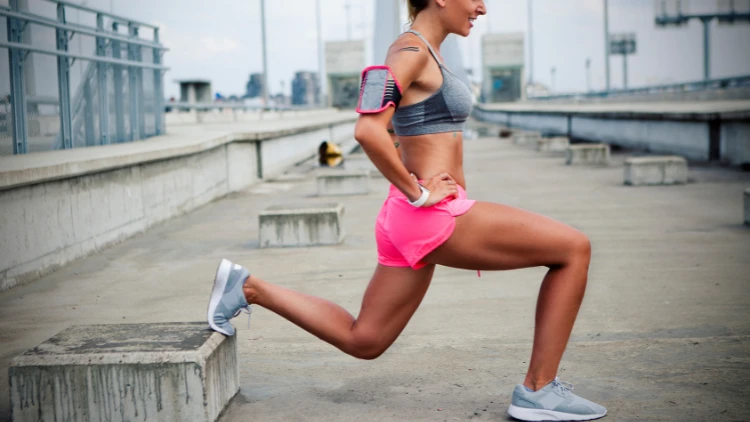
Source: M_a_y_a via Canva.com22
Bulgarian split squats, also known as an elevated rear foot squat, is a viable exercise that works the lower body targeting the glutes, quads, and to a lesser degree, the hamstrings. The Bulgarian split squat can be done even with body weight alone to reap benefits.23
- Body weight: These can be done without weights and can be performed conveniently anywhere.
- Alternative to the squat: This alternative to the squat matches the back squat in terms of muscle activation and is effective in targeting the same muscles.24
How to perform Bulgarian split squat: The exercise begins with a flat foot on the ground and the other foot on a bench, either flat or on toes. The front leg is the working leg, and the back is used for balance. Lower into a deep lunge and ensure the knees don’t pass the toes and ensure the chest remains up.
Where you should feel Bulgarian split squat: This exercise is felt in the glutes and quads, which are the primary movers. The hamstrings can be felt as well.
How To Find Which Stiff Legged Deadlift Alternative Is Right For You
To find which stiff-legged deadlift alternative is suitable for a lifter, someone should experiment with the exercises mentioned above and see what works best for them and what they enjoy doing the most. They engage the effectiveness of the workout by checking to see if they will be sore after the workout—DOMS (delayed onset muscle soreness).25
This aching feeling after a workout results from inflammation that develops on the muscles after they have been ‘damaged’ by eccentric exercises and is an indicator that the workout is effective. The result would be hypertrophy and strengthening of the muscle after repair.
Lifters should stick to the exercise, ensuring perfect form, and then cycle it a variation every 4-8 weeks—mix it up with another exercise from those above.
In addition, lifters should consider reps in reserve (RIR) when performing these alternatives. RIR in lifting refers to the number of reps that can still be done before failure. Ensuring that this is done within an individual’s ideal RIR would go a long way in ensuring sufficient volume is completed to achieve hypertrophy and strength.
Lifters who are injured, in pain, or looking for variation for the SLDS need not be concerned as the stiff leg deadlift alternative works even better, and 18 others will prove to be just as effective to ensure they can achieve their training objectives.
Frequently Asked Questions
Romanian vs. Deadlift Stiff Leg Deadlift: What’s The Difference?
The main difference is that Romanian deadlifts are performed by having the bar terminate at the level of the shin; the weight plates must never touch the floor between repetitions. Deadlift stiff leg deadlifts, on the other hand, halt at the platform between each successive rep. The implication is that the range of motion is longer than RDLs.
What’s The Difference Between Bulgarian Split Squats vs. Split Squats?
These two are often used interchangeably but are not the same thing. With the Bulgarian split squat, the rear leg is placed on a bench, but the split squat does not have the rear leg elevated.
References
1fotostorm. Canva. Accessed 11 April 2023. <https://www.canva.com/photos/MAEEKke2vEQ-female-body-builder-concentrating-while-doing-barbell-hip-thrust/>
2Изображения пользователя Andrii. Canva. Accessed 11 April 2023. <https://www.canva.com/photos/MAFbH0iFg74-young-caucasian-girl-in-the-gym-doing-an-exercise-for-the-back-with-dumbbells-deadlift-/>
3Plahutar, Ziga. Canva. Accessed 11 April 2023. <https://www.canva.com/photos/MAEJCG4GjMA-woman-doing-hip-thrust-with-barebell/>
4Medicine, N. L. (2019, June 1). Barbell Hip Thrust, Muscular Activation and Performance: A Systematic Review. Retrieved 2022, from <https://www.ncbi.nlm.nih.gov/pmc/articles/PMC6544005/>
5Medicine, N. L. (2018, March). Electromyographic Comparison of Barbell Deadlift, Hex Bar Deadlift, and Hip Thrust Exercises: A Cross-Over Study. Retrieved 2022, from <https://pubmed.ncbi.nlm.nih.gov/28151780/>
6Medicine, N. L. (2018, September 29). Relationship of Absolute and Relative Lower-Body Strength to Predictors of Athletic Performance in Collegiate Women Soccer Players. Retrieved from <https://www.ncbi.nlm.nih.gov/pmc/articles/PMC6316620/>
7photology2000. Canva. Accessed 11 April 2023. <https://www.canva.com/photos/MAEOs1brjmw-personal-trainer-helps-woman-do-a-single-leg-deadlift/>
8Bojan656. “Kettlebell swings.” Canva. Accessed 11 April 2023. <https://www.canva.com/photos/MADB4_ot20Y-kettlebell-swing/>
9Medicine, N. L. (2012, May). Effects of weightlifting vs. kettlebell training on vertical jump, strength, and body composition. Retrieved 2022, from <https://pubmed.ncbi.nlm.nih.gov/22344061/>
10Medicine, N. L. (2012, December 26). Mechanical demands of kettlebell swing exercise. Retrieved from <https://pubmed.ncbi.nlm.nih.gov/22344061/>
11Medicine, N. L. (2015, November 10). EMG Analysis and Sagittal Plane Kinematics of the Two-Handed and Single-Handed Kettlebell Swing: A Descriptive Study. Retrieved 2022, from <https://pubmed.ncbi.nlm.nih.gov/26618061/>
12Medicine, N. L. (2010, April 24). Oxygen cost of kettlebell swings. Retrieved 2022, from <https://pubmed.ncbi.nlm.nih.gov/20300022/>
13Medicine, N. L. (2015, January 29). Regional differences in muscle activation during hamstrings exercise. Retrieved 2022, from <https://pubmed.ncbi.nlm.nih.gov/22843044/>
14madproduction. Canva. Accessed 11 April 2023. <https://www.canva.com/photos/MAFLBvgeRPU-vertical-shot-of-a-strong-female-athlete-lifting-barbell-in-sumo-squat/>
15Ozimician. “Trap bar deadlift.” Canva. Accessed 11 April 2023. <https://www.canva.com/photos/MADFHg0GaCI-trap-bar-deadlift/>
16Bojan656. “Fit Girl performing deadlift.” Canva. Accessed 11 April 2023. <https://www.canva.com/photos/MADATCx1U28-fit-girl-performing-deadlift/>
17microgen. “Lying leg curls exercise.” Canva. Accessed 11 April 2023. <https://www.canva.com/photos/MAEEs5u5QP8-lying-leg-curls-exercise/>
18Medicine, N. L. (2013, May). Effects of kettlebell training on postural coordination and jump performance: a randomized controlled trial. Retrieved 2022, from <https://pubmed.ncbi.nlm.nih.gov/33009197/>
19Plahutar, Ziga. “Woman doing exercise for glutes.” Canva. Accessed 11 April 2023. <https://www.canva.com/photos/MAEEbTTcoxg-woman-doing-exercise-for-glutes/>
20LordHenriVoton. “Squat Workout.” Canva. Accessed 11 April 2023. <https://www.canva.com/photos/MAEEnPRWT9w-squat-workout/>
21Helgy. Canva. Accessed 11 April 2023. <https://www.canva.com/photos/MAESZBSpV-E-overweight-woman-working-out-at-the-gym/>
22M_a_y_a. “Sportswoman exercise.” Canva. Accessed 11 April 2023. <https://www.canva.com/photos/MAEJLxcGsdw-sportswoman-exercise/>
23Medicine, N. L. (2021, April 1). Biomechanical Differences Between the Bulgarian Split-Squat and Back Squat. Retrieved 2022, from <https://www.ncbi.nlm.nih.gov/pmc/articles/PMC8136570/>
24Medicine, N. L. (2014, October 1). Muscle Activity in Single- vs. Double-Leg Squats. Retrieved 2022, from <https://www.ncbi.nlm.nih.gov/pmc/articles/PMC4831851/>
25Wikipedia. (2022, August 8). Delayed onset muscle soreness. Retrieved 2022, from <https://en.wikipedia.org/wiki/Delayed_onset_muscle_soreness>